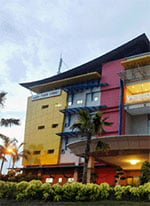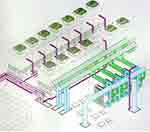Growing a cybercity
Malaysia’s multimedia city is at the heart of a nationwide transformation process to bring Malaysians into the Information Age.
DATE 2023-11-28 AUTHOR Siew Lyn WongIn the Malay language, “jaya” means “successful.” When Malaysia named its multimedia industry center “Cyberjaya,” the hope for success referred to more than the city. Malaysia is looking at using information and communications technology as a stepping stone to achieving developed nation status.
Innovative concept
 The target date: the year 2020. The means is an innovative concept called the Multimedia Super Corridor, of which Cyberjaya is an important part. This Corridor is both a physical area as well as a strategy. Measuring 15 by 50 kilometers, it is equipped with world-class infrastructure, including very fast telecommunications connections that allow people to use and develop the latest computer and Internet applications to work, live and play.
The target date: the year 2020. The means is an innovative concept called the Multimedia Super Corridor, of which Cyberjaya is an important part. This Corridor is both a physical area as well as a strategy. Measuring 15 by 50 kilometers, it is equipped with world-class infrastructure, including very fast telecommunications connections that allow people to use and develop the latest computer and Internet applications to work, live and play.
There are five cybercities on the Corridor,including the Kuala Lumpur City Center, which houses the world’s tallest twin towers, Putrajaya, the national administrative capital, and Cyberjaya.
Model cybercity
Cyberjaya is being developed as the model cybercity and head-quarters for technology led companies. Currently, 850 entities have received Multimedia Super Corridor status, entitling them to special tax, financial, employment and ownership benefits. A core group of these entities has set up in Cyberjaya; it includes multinationals, research institutions and small- and medium-sized enterprises.
Former oil palm estate
 Spreading over 2,890 hectares (7,141 acres) of former oil palm estates south of the capital of Kuala Lumpur, Cyberjaya is slowly developing toward being a healthy, attractive business and living environment. The aim is for extensively landscaped surroundings and spaciousness, thanks to master plans and standards. These include limits on building heights and a maximum population of 250,000 by 2020 — small for a city by Malaysian standards. In the pipeline are such centers for socializing and community-building as a street mall and a food court, which provide an out-of-office casual atmosphere where innovative ideas can be generated.
Spreading over 2,890 hectares (7,141 acres) of former oil palm estates south of the capital of Kuala Lumpur, Cyberjaya is slowly developing toward being a healthy, attractive business and living environment. The aim is for extensively landscaped surroundings and spaciousness, thanks to master plans and standards. These include limits on building heights and a maximum population of 250,000 by 2020 — small for a city by Malaysian standards. In the pipeline are such centers for socializing and community-building as a street mall and a food court, which provide an out-of-office casual atmosphere where innovative ideas can be generated.
“But we are not Silicon Valley,” stresses Najat Ahmad Marzuki, senior manager for corporate affairs for the Multimedia Development Corporation, the autonomous body that coordinates activities in the Corridor and answers directly to Malaysian Prime Minister Mahathir Mohamad. “Our objective is socioeconomic progress.”
Electronic ID
An example of the flagship applications thathave come out of the Multimedia Super Corridor is MyKad, the electronic identity card that all 22 million Malaysians must carry. It includes personal information such as driver’s license and health details, and doubles as a debit card. Another application involves electronic procurement, where all transactions between the 4,300 government procurement agencies and 35,000 government suppliers nationwide must be done through the Internet. The value of the supplies and services will come up to 8 to 10 billion Malaysian ringgit (2 to 3 billion US dollars) this year.
Forerunner
When the concept was launched in 1996, the Multimedia Super Corridor was the first of its kind in the world. Such prestigious publications as Wired and the International Herald Tribune referred to it as “the planet’s most seductive technopark.” Recently (March 2003), the Dutch government invited Malaysia to be one of four pioneer countries and the Asian hub for the global Smart Community International Network, which links high-technology community projects in different countries.
Superskills needed
Nonetheless, the Corridor initiative faces challenges. A key issue is building up a critical mass of trained, creative workers who also have business acumen, But “superskills” are lacking, says Najat. “We still need people from overseas who can transfer technology and skills to locals.” But chances are good that Malaysians will rise to fill the gap; in the 1980s the country saw success doing just that in the electronics industry, with Malaysians eventually taking over management positions in global manufacturing giants such as Intel and Hitachi.
Performance improvements
Meanwhile, to ensure that the coordination of activities in the Multimedia Super Corridor runs more smoothly, Najat says key performance improvements must be put in place. These are based on a commissioned review that was done in 2002 by an external, neutral consultancy. Recommendations include cutting down on bureaucracy, being more responsive to client needs and customizing incentives.
Chaired by the prime minister
These strategies would help Multimedia Super Corridor entities meet the challenges of the current global recession, globalization and increased competition, particularly from China. Moreover, advising the Malaysian government on the Multimedia Super Corridor’s direction is an International Advisory Panel chaired by the prime minister, comprising such major players in the global industry as Microsoft’s Bill Gates and Acer’s Stan Shih. A cabinet-level Implementation Council also meets quarterly — likewise the industry-level National Technopreneurs Association.
Can Cyberjaya live up to its name? The challenges are plentiful, but the Multimedia Super Corridor is already a third of its way to the goal of creating a knowledge society, built on the fast-tracking “miracle” of information and communication technology and backed by government willpower.
District cooling in Cyberjaya
Reliability is crucial in an ever growing development such as Cyberjaya, Malaysia’s new multimedia city.
District cooling service provider Pendinginan Megajana Sdn. Bhd. (PMSB) supplies chilled water to buildings through more than 15 kilometers of underground piping. Building owners and tenants are billed monthly according to usage via a remote data collection system.
Ice balls for chilling
The district cooling plant uses a state-of-the-art ice thermal storage system to produce ice during off-peak hours (nighttime), thus take advantage of lower electricity tariffs.
This cooling energy is stored in patented encapsulated ice balls, which are then used to chill the pipeline during peak hours (daytime) with the help of Alfa Laval’s plate heat exchangers. The ice balls are also used to chill the ethylene glycol water within the district cooling plant. Water within the plant has to operate at well below zero degrees Celsius (32 degrees Fahrenheit); ethylene glycol water prevents the water from freezing.
Alfa Laval’s plate heat exchangers are used to transfer energy from the cooling plant to the external distribution pipeline. These heat exchangers are strategically important to prevent contamination from the external chilled water pipeline, which would affect the performance of the cooling plant. Cleaning up in the event of contamination in the underground pipeline would present PMSB with a formidable task.
Contamination control
Minimizing contamination is one of the most important risk management strategies practiced by Megajana. Thus Megajana has chosen to install plate heat exchangers in the main plant where chilled water is produced, and at customers’ premises. The use of plate heat exchangers in these facilities enables the chilled water piping to be isolated into three loops: the main plant, the external distribution network, and the customers’ internal piping. The heat exchangers are used between each loop to prevent contamination from one loop to another.
World class infrastructure
As the city’s sole supplier of chilled water for air conditioning, PMSB conforms to performance guarantees set by the Malaysian government to provide world class infrastructure in the Multimedia Super Corridor. Other than scheduled supply interruptions, the guarantee states that service must be available 99.9 percent per month. Thus, says the general manager, any kind of downtime is seen as nonconformance to the guarantee to Corridor investors. “We are not merely a utility provider, but a part of the development of Cyberjaya,” he adds.
Another three plants
Alfa Laval plate heat exchangers also meet the company’s scalability needs. Eight heat exchangers enable chilled water production up to 12,000 refrigerant tons (RTs).
The plant has a planned capacity of 50,000 RTs. An additional three plants with the same capacity — all using plate heat exchangers — have been planned to eventually service the whole of Cyberjaya by its projected completion date of 2020.
Benchmark
Alfa Laval plate heat exchangers have other benefits, says Bernard Loh, managing director of UAT Air Conditioning Sdn. Bhd., the design-and-build contractor for Phase 2 of the Control District Cooling Plant. These include cost-effectiveness, a 20-plus-year equipment life span, minimal maintenance requirements and an efficient after-sales service.
“Building owners in Cyberjaya always have a choice when selecting a provider for their chilled water needs,” says Loh. But PMSB has proven to be a highly competitive and reliable utility supplier, with many new and repeat customers. In a project such as the cooling plant in Cyberjaya, successful implementation depends on a good working relationship and support between the owner (PMSB), the design-and-build contractor (UAT Air Conditioning Sdn. Bhd.) and suppliers such as Alfa Laval. As Bernhard Loh says, everyone must play his part to successfully implement the project.
